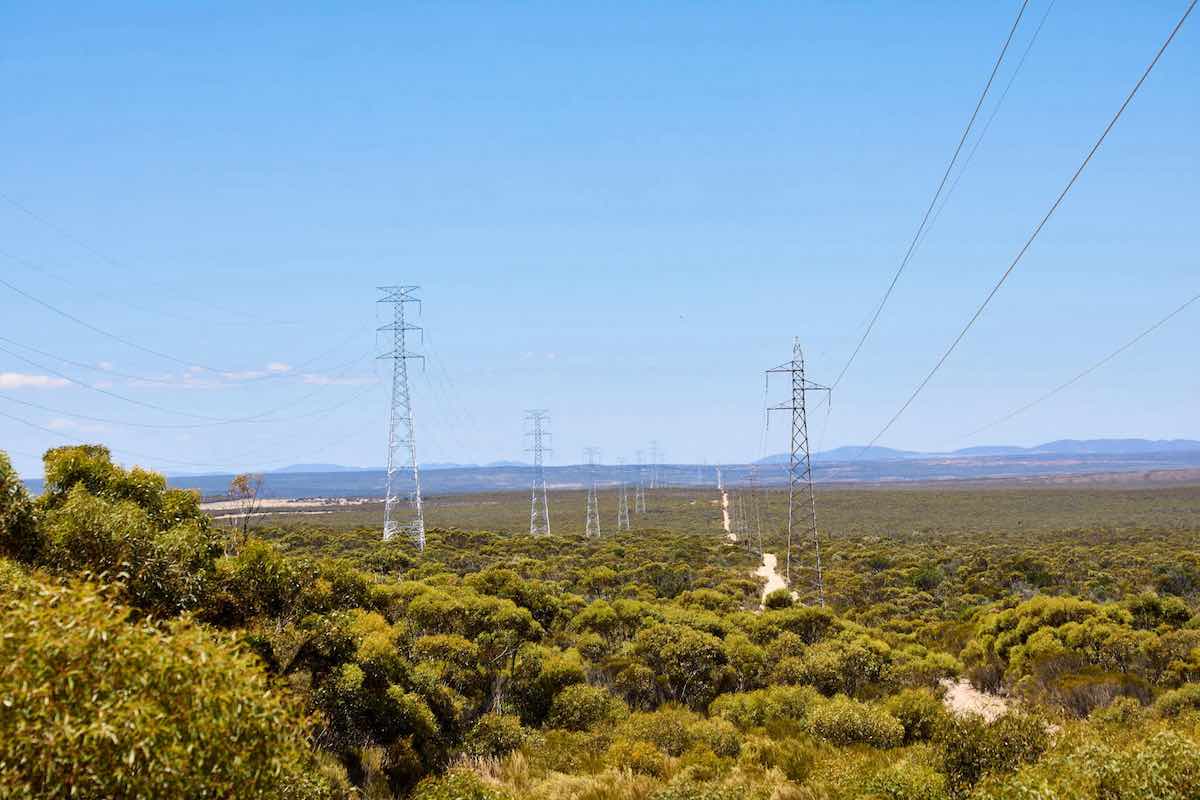Australia’s electricity transmission ideas are mired in arguments around big new lines and community engagement, but there is growing excitement in the US around new ways of getting more out of the same line – and at a fraction of the cost.
Transmission network service providers in South Australia, Victoria and New South Wales (NSW) are also testing grid enhancing technologies, or GETs, across their networks, to see if they can replicate the big savings being reported overseas.
Studies in the US, for instance, show that these technologies can double the capacity of a network, others can deliver upgrades at a fraction of the cost of traditional methods. Are they applicable in Australia? Network companies are keen to find out.
One of these GETs is known as “Reconductoring.” This involves replacing the copper metal inside power lines with high voltage superconducting cables that wrap aluminium with carbon fibre instead of steel, so they deliver more electricity with less impact from outside temperatures or electrical resistance.
Another GET is Dynamic line ratings (DLRs), which use sensors to measure local weather conditions to show whether a transmission line has more or less capacity in real time are already in use.
Another is Advanced power flow control (PFCs) technology, which add valves to create resistance on lines at peak capacity to shift the loads onto others. This, network experts tell us, has been tried in Australia, with mixed results.
In Victoria, network operator AusNet says it didn’t get enough bang for buck out of its PFC trial, but across the border in NSW Transgrid is so enamoured it plans to build it into the future VNI West transmission line.
GETs are definitely on the radar, even if they’re not completely here yet.
“Evaluations of pilot studies in the United States —and some commercial-scale operations in Europe and the United Kingdom—show that these technologies can boost the capacity of an existing transmission network anywhere from a few percent, for a single power line, to more than 100 percent, for a complex grid with many possible routes for power,” noted an article in the Journal PNAS in January.
“That translates to potentially billions of dollars in savings from mitigating both congestion costs and the infrastructure costs required to build new transmission lines.”
Unbunging a US grid
A new study into the cheaper-and-cheerful methods of jamming more renewables into transmission lines suggests GETs could unstick one of the most bunged up networks in the US – the eastern PJM.
The PJM grid completely stopped new connections from renewables for two years at the end of 2022 because it believes it doesn’t have the capacity to carry them.
But the report by RMI said it could add 6 gigawatts (GW) of new generation in three years if it began using dynamic line ratings (DLRs), which use sensors to measure local weather conditions to show whether a transmission line has more or less capacity in real time, advanced power flow control (PFCs) which add valves to create resistance on lines at peak capacity to shift the loads onto others, and topology optimization (TO) which uses circuit breakers to reroute power flows.
“Compared with standard network upgrades, such as reconductoring or rebuilding a line, GETs deployment costs ranged from $US272 million to $US523 million less across the study footprint,” the RMI report found, for an area covering five of the 14 states and regions the network operates in.
That price difference equates to 81-98 per cent cheaper than re-wiring a transmission line.
“In our production cost modelling analysis, we find that GETs-enabled new generators and reduced congestion would reduce energy production costs by just under $US1 billion in 2027, ramping up to over $US1 billion in savings per year by 2030.”
The difference with Australia, however, is that the PJM grid is much more condensed: it delivers power across 13 states and one district but just six of those states contain more people than Australia in a land area that would fit inside NSW. .
Squeezing out a bit extra
Dynamic line ratings are already commonplace in Australia, a technology that can squeeze an extra 20-30 per cent of capacity out of transmission lines by knowing when a breeze is cooling power cables.
A transmission line’s rating is its designed current-carrying capacity, based on the temperature sensitivity of the conductor within the power line.
High temperatures can reduce the amount of current that can pass through and can cause a power line to sag too much. Transmission companies have to estimate that rating for all lines, which results in underutilised capacity.
By using sensors and other technologies, companies can use dynamic line ratings instead that factor in local weather conditions.
The innovation is how to get the sensors onto the power lines – and one being used in NSW was actually built in Australia.
In 2022, Australian company Infravision won funding from ARENA to use drones to drop 20 sensor units onto live transmission lines owned by TransGrid,
The Next Generation Dynamic Line Monitoring System was supposed to provide real-time information about the line and the local weather, and allow TransGrid to better use its lines.
Transgrid network EGM Marie Jordan says it means they don’t have to shut down high-use lines to install sensors and the drones can even replace batteries and do on-site inspections.
An AusNet spokesperson said that although it uses the technology and it could deliver “significant benefits”, system security meant more transmission infrastructure is required.
Reconductoring is another option which is already used by transmission companies, but which is harder to get past the Australian Energy Regulator on cost grounds.
Transgrid ditched an option to do reconductoring on the Queensland-NSW Interconnector (QNI) upgrade on the grounds of expense in 2020, but is using them elsewhere in the state.
Upgraded power lines can carry twice as much power as conventional lines without having to negotiate new rights of way, found a study from the Energy Institute at the UC Berkeley Haas School of Business.
“We have started using superconductors in our area, it’s just one location so far in our system. We’re in a regulatory investment test right now with the regulator for another,” says Jordan.
“It holds promise where we already have lines built and need to move more capacity over them. But the challenge in Australia is not just capacity, it’s voltage stability.
“We aren’t ignoring the technology, we’re putting it in our regulatory investment test to see if it will make sense for Australia.”
Jordan was referring to High Temperature Low Sag (HTLS) conductors being used in lines on the Snowy 2.0 connection and others.
However, a true “superconductor” cable is the next step — and one that is not yet under consideration in Australia: an underground, liquid nitrogen-cooled cable kept at a temperature of -200℃.
A single superconducting cable can deliver the same amount of power in a smaller package at lower voltage, wrote Queensland University of Technology’s Ian Mackinnon and Richard Taylor last year in The Conversation.
“What about cost? This is hard to pin down, as it depends on the scale, nature and complexity of the task. But consider this — the Essen cable [in Germany] cost around $20m in 2014. Replacing the six 500kV towers destroyed by windstorms near Moorabool in January 2020 cost $26 million,” they wrote.
Redirecting power flows
Electrons will always take the path of least resistance, so advanced power flow controls (PFCs) use different methods to change this pathway and shift electrons from at-capacity wires to lesser used ones.
In Australia, this isn’t used often yet and when it is, it’s with mixed results.
One of the few companies to offer it is a US import called Smart Wires.
It has sold its Smart Valves tech to ElectraNet in South Australia to open up an extra 17 MW and reduce wind curtailment; to AusNet in Victoria on the Jindera-Wodonga transmission line to route power flows onto the underused western 330 kV transmission corridor and unlock about 15 MW of capacity; and at Transgrid’s Stockdill and Yass substations in the ACT to open up a total 170 MW of capacity.
“The application of Smart Wires at Wodonga Terminal Station was not very successful because the increase in power flows achieved was minimal, and it is unlikely that we will use this technology elsewhere,” an AusNet spokesperson told RenewEconomy.
“There are other proven technologies that deliver far greater opportunity to control flows on the transmission system and enhance flows over exiting lines, such as series capacitor banks (with or without controls).”
The Transgrid experience was better, with the company intending to use the technology on the new VNI West interconnector when it is built, says network EGM Jordan.
“The Smart Valve technology adds resistance to the wires and changes the flows,” she says.
“When we looked at VNI, we thought about how we maximise a 550 kV line.”
Too cheap?
One of the bonuses of grid enhancing technologies is that they’re significantly cheaper than alternatives.
For example, when Transgrid was originally pitching the modular power flow tech for the Canberra-Tumut-Yass lines on the new VNI West interconnector in 2020, it produced a report finding it would cost $99 million to upgrade power lines and $87 million to instead add advanced power flow controls.
The other two options were bringing forward one leg of the Humelink transmission line from Snowy 2.0 at $628 million, or doing that and rebuild part of the existing 330kV South Morang-Dederang line in Victoria for almost $1 billion.
Price is an issue for network companies: they say it’s all up to the regulator what they’re allowed to spend.
But one study suggests they’re not spending or innovating enough.
Between 2014 and 2021 Australian network companies charged consumers $10 billion more than they needed to, according to IEEFA.
“Every five years, the AER determines the future revenue the networks require to cover their costs for the next five-year period, and networks charge approved prices to consumers via retailers,” it said.
“There is no evidence to suggest that networks are achieving meaningful improvements in productivity that might justify their abnormally high returns.”
This is even when real-world data is beginning to show just how much cheaper grid-enhancing tech is compared to the payoff.
What is not yet being used in Australia to any degree is topology optimisation, software that is only just emerging into real-world use from the lab.
It complements power flow controls by using algorithms to further reroute electrons around congested areas of the grid.
A Boston-based startup called NewGrid has found that in congested networks such as the PJM and the Southwest Power Pool it can relieve congestion by 30-50 per cent.
The latter network discovered that if it opened a transmission line a few substations up from a heavily congested Oklahoma area, they could reduce power flows through the network there by a quarter and reduce prices in the worst areas from $US600/MWh to $US25/MWh.









